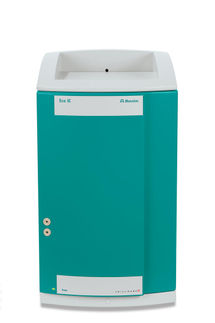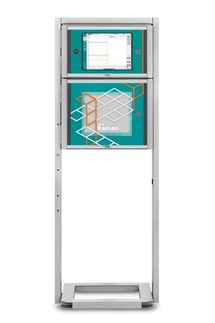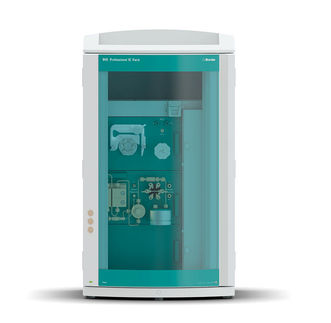To use all functions of this page, please activate cookies in your browser.
my.chemeurope.com
With an accout for my.chemeurope.com you can always see everything at a glance – and you can configure your own website and individual newsletter.
- My watch list
- My saved searches
- My saved topics
- My newsletter
Radiology
Product highlight
SubdivisionsAs a medical specialty, radiology can be classified broadly into Diagnostic radiology and Therapeutic radiology.
Acquisition of radiological imagesPatients have the following procedures to provide images for Radiological decisions to be made. Projection (plain) radiographyRadiographs (or Roentgenographs, named after the discoverer of X-rays, Wilhelm Conrad Roentgen (1845-1923)) are often used for evaluation of bony structures and soft tissues. An X-Ray machine directs electromagnetic radiation upon a specified region in the body. This radiation tends to pass through less dense matter (air, fat, muscle, and other tissues), but is absorbed or scattered by denser materials (bones, tumors, lungs affected by severe pneumonia). In Film-Screen Radiography, radiation which has passed through a patient then strikes a cassette containing a screen of fluorescent phosphors and exposes x-ray film. Areas of film exposed to higher amounts of radiation will appear as black or grey on X-ray film while areas exposed to less radiation will appear lighter or white. In Computed Radiography (CR), the x-rays passing through the patient strike a sensitized plate which is then read and digitized into a computer image by a separate machine. In Digital Radiography the x-rays strike a plate of x-ray sensors producing a digital computer image directly. While all three methods are currently in use, the trend in the U.S. is away from film and toward digital imaging. Plain radiography was the only imaging modality available during the first 50 years of Radiology. It is still the first study ordered in evaluation of the lungs, heart and skeleton because of its wide availability, speed and relative low cost. FluoroscopyFluoroscopy and angiography are special applications of X-ray imaging, in which a fluorescent screen or image intensifier tube is connected to a closed-circuit television system, which allows real-time imaging of structures in motion or augmented with a radiocontrast agent. Radiocontrast agents are administered, often swallowed or injected into the body of the patient, to delineate anatomy and functioning of the blood vessels, the genitourinary system or the gastrointestinal tract.Two radiocontrasts are presently in use. Barium (as BaSO4) may be given orally or rectally for evaluation of the GI tract. Iodine, in multiple proprietary forms, may be given by oral, rectal, intraarterial or intravenous routes. These radiocontrast agents strongly absorb or scatter X-ray radiation, and in conjunction with the real-time imaging allows demonstration of dynamic processes, such as peristalsis in the digestive tract or blood flow in arteries and veins. Iodine contrast may also be concentrated in abnormal areas more or less than in normal tissues and make abnormalities (tumors, cysts, inflammation) more conspicuous. Additionally, in specific circumstances air can be used as a contrast agent for the gastrointestinal system and carbon dioxide can be used as a contrast agent in the venous system; in these cases, the contrast agent attenuates the X-ray radiation less than the surrounding tissues. CT scanningCT imaging uses X-rays in conjunction with computing algorithms to image the body. In CT, an X-ray generating tube opposite an X-ray detector (or detectors) in a ring shaped apparatus rotate around a patient producing a computer generated cross-sectional image (tomogram). CT is acquired in the axial plane, while coronal and sagittal images can be rendered by computer reconstruction. Radiocontrast agents are often used with CT for enhanced delineation of anatomy. Intravenous contrast can allow 3D reconstructions of arteries and veins. Although radiographs provide higher spatial resolution, CT can detect more subtle variations in attenuation of X-rays. CT exposes the patient to more ionizing radiation than a radiograph. Spiral Multi-detector CT utilizes 8,16 or 64 detectors during continuous motion of the patient through the radiation beam to obtain much finer detail images in a shorter exam time. With computer manipulation these images can be reconstructed into 3D images of carotid, cerebral and coronary arteries. Faster scanning times in modern equipment has been associated with increased utilization. UltrasoundMedical ultrasonography uses ultrasound (high-frequency sound waves) to visualize soft tissue structures in the body in real time. No ionizing radiation is involved, but the quality of the images obtained using ultrasound is highly dependent on the skill of the person (ultrasonographer) performing the exam. Ultrasound is also limited by its inability to image through air (lungs, bowel loops) or bone. The use of ultrasound in medical imaging has developed mostly within the last 30 years. The first ultrasound images were static and two dimensional (2D), but with modern-day ultrasonography 3D reconstructions can be observed in real-time; effectively becoming 4D. Because ultrasound does not utilize ionizing radiation, unlike radiography, CT scans, and nuclear medicine imaging techniques, it is generally considered safer. For this reason, this modality plays a vital role in obstetrical imaging. Fetal anatomic development can be thoroughly evaluated allowing early diagnosis of many fetal anomalies. Growth can be assessed over time, important in patients with chronic disease or gestation-induced disease, and in multiple gestations (twins, triplets etc.). Color-Flow Doppler Ultrasound measures the severity of peripheral vascular disease and is used by Cardiology for dynamic evaluation of the heart, heart valves and major vessels. Stenosis of the carotid arteries can presage cerebral infarcts (strokes). DVT in the legs can be found via ultrasound before it dislodges and travels to the lungs (pulmonary embolism), which can be fatal if left untreated. Ultrasound is useful for image-guided interventions like biopsies and drainages such as thoracentesis). It is also used in the treatment of kidney stones (renal lithiasis) via lithotripsy. Small portable ultrasound devices now replace peritoneal lavage in the triage of trauma victims by directly assessing for the presence of hemorrhage in the peritoneum and the integrity of the major viscera including the liver, spleen and kidneys. Extensive hemoperitoneum (bleeding inside the body cavity) or injury to the major organs may require emergent surgical exploration and repair. MRIMRI uses strong magnetic fields to align spinning atomic nuclei (usually hydrogen protons) within body tissues, then uses a radio signal to disturb the axis of rotation of these nuclei and observes the radio frequency signal generated as the nuclei return to their baseline states. The radio signals are collected by small antennae, called coils, placed near the area of interest. An advantage of MRI is its ability to produce images in axial, coronal, sagittal and multiple oblique planes with equal ease. MRI scans give the best soft tissue contrast of all the imaging modalities. With advances in scanning speed and spatial resolution, and improvements in computer 3D algorithms and hardware, MRI has become an essential tool in musculoskeltal radiology and neuroradiology. One disadvantage is that the patient has to hold still for long periods of time in a noisy, cramped space while the imaging is performed. Claustrophobia severe enough to terminate the MRI exam is reported in up to 5% of patients. Recent improvements in magnet design including stronger magnetic fields (3 teslas), shortening exam times, wider, shorter magnet bores and more open magnet designs, have brought some relief for claustrophobic patients. However, in magnets of equal field strength there is often a trade-off between image quality and open design. MRI has great benefit in imaging the brain, spine, and musculoskeletal system. The modality is currently contraindicated for patients with pacemakers, cochlear implants, some indwelling medication pumps, certain types of cerebral aneurysm clips, metal fragments in the eyes and some metallic hardware due to the powerful magnetic fields and strong fluctuating radio signals the body is exposed to. Areas of potential advancement include functional imaging, cardiovascular MRI, as well as MR image guided therapy.
Nuclear medicineNuclear medicine imaging involves the administration into the patient of radiopharmaceuticals consisting of substances with affinity for certain body tissues labeled with radioactive tracer. The most commonly used tracers are Technetium-99m, Iodine-123, Iodine-131 and Thallium-201. The heart, lungs, thyroid, liver, gallbladder, and bones are commonly evaluated for particular conditions using these techniques. While anatomical detail is limited in these studies, nuclear medicine is useful in displaying physiological function. The excretory function of the kidneys, iodine concentrating ability of the thyroid, blood flow to heart muscle, etc. can be measured. The principal imaging device is the gamma camera which detects the radiation emitted by the tracer in the body and displays it as an image. With computer processing, the information can be displayed as axial, coronal and sagittal images (SPECT images). In the most modern devices Nuclear Medicine images can be fused with a CT scan taken quasi-simultaneously so that the physiological information can be overlaid or co-registered with the anatomical structures to improve diagnostic accuracy. PET scanning also falls under "nuclear medicine." In PET scanning, a radioactive biologically-active substance, most often Fluorine-18 Fluorodeoxyglucose, is injected into a patient and the radiation emitted by the patient is detected to produce multi-planar images of the body. Metabolically more active tissues, such as cancer, concentrate the active substance more than normal tissues. PET images can be combined with CT images to improve diagnostic accuracy. The applications of nuclear medicine can include bone scanning which traditionally has had a strong role in the work-up/staging of cancers. Myocardial perfusion imaging is a sensitive and specific screening exam for reversible myocardial ischemia, which when present requires angiographic confirmation and potentially life-saving balloon angioplasty, stenting or cardiac bypass grafting. Molecular Imaging is the new and exciting frontier in this field. Radiologist trainingTemplate:World view United StatesDiagnostic radiologists must complete prerequisite undergraduate training, four years of medical school, and five years of post-graduate training. The first postgraduate year is usually a transitional year of various rotations, but is sometimes a preliminary internship in medicine or surgery. A four-year diagnostic radiology residency follows. During this residency, the radiology resident must pass a medical physics board exam covering the science and technology of ultrasounds, CTs, x-rays, nuclear medicine, and MRI. After successful completion of their residency, the new radiologist is eligible to take board examinations (written and oral) given by the American Board of Radiology. Following completion of residency training, radiologists either begin their practice or enter into sub-speciality training programs known as fellowships. Examples of sub-speciality training in radiology include abdominal imaging, thoracic imaging, CT/Ultrasound, MRI, musculoskeletal imaging, interventional radiology, neuroradiology, interventional neuroradiology, pediatric radiology, and women's imaging. Fellowship training programs in radiology are usually 1 or 2 years in length. Radiology is currently considered a highly competitive field. Radiologists generally enjoy good compensation as well as a good balance between time required at work and time spent away from work. The field is rapidly expanding due to advances in computer technology which is closely linked to modern imaging. The exams (radiography) are usually performed by radiologic technologists, (also known as diagnostic radiographers) who in the United States have a 2-year Associates Degree and the UK a 3 year Honours Degree. Veterinary radiologists are veterinarians that specialize in the use of X-rays, ultrasound, MRI and nuclear medicine for diagnostic imaging or treatment of disease in animals. Veterinary radiologists are certified in either diagnostic radiology or radiation oncology by the American College of Veterinary Radiology. Australia and New ZealandRadiology training begins after completion of medical degree (6 years) and at least 2 years of hospital residency (internship and junior house medical officer (JHMO) ). It then comprises 5 years , one of which can be a fellowship. See also^ |
|
| This article is licensed under the GNU Free Documentation License. It uses material from the Wikipedia article "Radiology". A list of authors is available in Wikipedia. |







